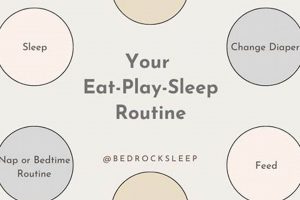The practice of gently swaying a baby until they fall asleep is a common and often comforting method employed by caregivers. It involves rhythmic movement designed to soothe the infant and induce sleep, frequently utilizing rocking chairs, cradles, or simply holding the baby while swaying. This action aims to replicate the sensations experienced in the womb, which are associated with safety and relaxation.
Such soothing techniques can offer several advantages, including promoting bonding between caregiver and child and assisting in the regulation of the infant’s sleep patterns. Historically, rocking and similar motions have been used across cultures to calm and nurture babies, representing a deeply ingrained caregiving behavior. However, reliance on external sleep aids can also lead to certain dependencies as the child develops.
Considerations surrounding the cessation of such sleep practices center on the infant’s developmental stage, the potential for sleep associations, and the caregiver’s preferences. Evaluation of these factors is essential in determining an appropriate time to transition towards independent sleep habits. Exploring these topics provides a comprehensive understanding of navigating sleep patterns as the baby grows.
Guidance on Discontinuing Rocking to Induce Sleep
The following recommendations provide guidance on when and how to transition away from using rocking as the primary method to lull a baby to sleep. These suggestions emphasize gradual adjustments and observation of the infant’s cues.
Tip 1: Observe the Infant’s Sleep Cues: Monitor the infant for signs of drowsiness, such as eye-rubbing, yawning, or decreased activity. Initiate the bedtime routine when these cues are evident, rather than relying solely on a fixed schedule.
Tip 2: Establish a Consistent Bedtime Routine: Implement a predictable sequence of events leading up to bedtime, such as a bath, reading a story, and singing a lullaby. This routine signals to the infant that it is time to sleep, independent of rocking.
Tip 3: Gradually Reduce Rocking Duration: Decrease the amount of time spent rocking the infant each night. Over a period of several days or weeks, gradually shorten the duration until the infant is placed in the crib while still awake.
Tip 4: Introduce Sleep Environment Associations: Place the infant in the crib while drowsy but awake, allowing the infant to associate the crib with sleep onset. This fosters self-soothing capabilities.
Tip 5: Provide Comforting Alternatives: Offer a pacifier or a soft, safe toy for the infant to hold while falling asleep. These items can provide comfort and security in the absence of rocking.
Tip 6: Respond to Infant’s Cries with Measured Intervention: If the infant cries, provide reassurance with gentle words and a brief touch. Avoid immediately picking up and rocking the infant, allowing the infant to attempt to self-soothe first.
Tip 7: Maintain Consistency: Consistency in the bedtime routine and response to nighttime awakenings is crucial for establishing healthy sleep habits. Avoid reverting back to rocking if the infant resists the transition initially.
Adherence to these recommendations, emphasizing gradual adjustments and consistent responses, can facilitate a smooth transition away from reliance on rocking to initiate sleep, promoting healthier and more independent sleep patterns in infants.
Consideration of these strategies is essential in developing a proactive approach to fostering independent sleep skills as the baby matures.
1. Developmental Milestones
The progression of an infant through various developmental stages directly influences the appropriateness of employing rocking as a sleep aid. As infants mature, their capacity for self-soothing increases, reducing the necessity for external assistance to initiate sleep. For example, a newborn, whose nervous system is still developing, benefits significantly from the rhythmic motion provided by rocking, as it mimics the intrauterine environment. However, by approximately four to six months of age, many infants begin exhibiting signs of increased self-regulation. This period often coincides with the development of motor skills, such as rolling over, and cognitive advancements, enabling them to find comfort independently. Delaying the transition away from rocking beyond this point might inadvertently hinder the development of independent sleep skills.
Furthermore, specific developmental milestones serve as indicators of an infant’s readiness for independent sleep. The ability to grasp and manipulate objects, typically emerging around six months, allows infants to find solace in a soft toy or blanket, diminishing the need for rocking. Similarly, the development of object permanence, the understanding that objects continue to exist even when out of sight, enables infants to feel secure in their cribs without the constant presence of a caregiver. These milestones demonstrate an evolving sense of security and self-awareness, which are essential for successful self-soothing and transitioning away from rocking.
In summary, monitoring developmental milestones provides a valuable framework for determining when to discontinue rocking as a sleep aid. While rocking serves a beneficial purpose in early infancy, observing key developmental advancements indicates an infant’s readiness for more independent sleep practices. Aligning sleep interventions with developmental progress optimizes the infant’s ability to self-soothe and establish healthy sleep habits. Failure to recognize and respond to these developmental cues may inadvertently prolong reliance on external sleep aids, potentially hindering the acquisition of essential self-regulation skills.
2. Sleep Association Formation
Sleep association formation plays a crucial role in determining the appropriate timing for discontinuing rocking as a sleep aid. The concept refers to the infant’s learning to associate specific stimuli or actions with the onset of sleep. These associations, once established, can become necessary conditions for the infant to fall asleep and, subsequently, to return to sleep after natural awakenings.
- Conditioned Dependence
Rocking, when consistently employed, can become a conditioned stimulus, where the infant learns to require the motion in order to initiate sleep. This conditioned dependence can hinder the development of independent sleep skills, as the infant may struggle to fall asleep without the presence of rocking. Over time, the strength of this association increases, making it more difficult to transition away from rocking. The continued use of rocking beyond infancy may perpetuate this dependence, requiring increased intervention to break the association.
- Impact on Night Wakings
Infants naturally experience brief awakenings throughout the night. If rocking is consistently used to induce sleep initially, the infant may signal for or expect the same stimulus to return to sleep after these awakenings. This can lead to frequent parental intervention during the night, disrupting both the infant’s sleep cycle and the caregiver’s sleep. The expectation of rocking as a sleep aid can contribute to fragmented sleep patterns and hinder the infant’s ability to self-soothe and independently return to sleep.
- Timing of Intervention
The timing of intervention to address sleep associations is critical. Early intervention, typically before six months of age, can be more effective as the associations are not as firmly established. Introducing alternative soothing methods before a strong reliance on rocking develops can promote the development of independent sleep skills. Delaying intervention until later in infancy or toddlerhood may require more intensive strategies and longer periods of adjustment as ingrained sleep associations are more challenging to modify.
- Creating Positive Associations
The focus should shift from dependence on rocking to the creation of positive sleep associations with the sleep environment itself. A consistent bedtime routine, a comfortable sleep space, and the introduction of a transitional object, such as a soft toy, can help the infant associate these elements with feelings of safety and security, facilitating self-soothing. This approach helps the infant learn to rely on internal resources, rather than external stimuli like rocking, to initiate and maintain sleep. Over time, the crib itself becomes associated with relaxation and sleep, promoting a healthier and more independent sleep cycle.
Addressing sleep association formation requires careful consideration of the infant’s developmental stage, the strength of the association, and the caregiver’s preferences. By recognizing the potential for dependence on rocking and actively working to foster independent sleep skills, caregivers can help their infants develop healthy sleep habits that promote long-term well-being and reduce the burden of frequent nighttime interventions.
3. Self-Soothing Capacity
The inherent ability of an infant to independently regulate its emotional state and initiate sleep, termed “self-soothing capacity,” is a critical determinant in evaluating the appropriate time to discontinue rocking as a primary sleep aid. Developing this capacity fosters independence and contributes to more consolidated and restorative sleep patterns.
- Development of Regulatory Skills
Self-soothing encompasses a range of learned behaviors that enable infants to calm themselves without external intervention. These skills develop gradually over the first year of life and include thumb-sucking, grasping a comfort object, or engaging in repetitive movements. The presence of these behaviors suggests a growing capacity to manage distress and initiate sleep independently. Continued reliance on rocking beyond the emergence of these skills may inadvertently hinder their further development and consolidation.
- Impact on Sleep Consolidation
Infants who possess strong self-soothing skills tend to experience more consolidated sleep patterns, characterized by fewer and shorter nighttime awakenings. The ability to independently return to sleep after natural arousals reduces the need for caregiver intervention, fostering a more restful sleep environment for both the infant and the parents. Rocking, as an external sleep aid, may disrupt this natural process by creating a reliance on external stimulation rather than internal regulatory mechanisms.
- Assessment of Self-Soothing Readiness
Determining an infant’s readiness for independent sleep involves careful observation of their behavior during periods of mild distress. Placing a drowsy but awake infant in the crib and observing their response provides valuable insights into their self-soothing capabilities. If the infant is able to settle down and fall asleep independently, it suggests a readiness to transition away from rocking. Conversely, if the infant consistently requires external intervention to initiate sleep, further support and gradual introduction of self-soothing techniques may be necessary.
- Gradual Transition Strategies
When transitioning away from rocking, gradual and supportive strategies are essential to facilitate the development of self-soothing skills. Reducing the duration of rocking gradually, while simultaneously providing alternative comfort measures such as a pacifier or a soft toy, allows the infant to learn to rely on internal regulatory mechanisms. Responding promptly but non-intrusively to the infant’s cries, providing verbal reassurance without immediately picking them up, encourages self-soothing attempts and reinforces their capacity to manage distress independently.
The development of self-soothing capacity is a dynamic process that varies across individual infants. Recognizing and responding to the infant’s cues, and tailoring sleep interventions to their individual needs, is crucial for promoting healthy sleep habits and fostering independence. Understanding how self-soothing skills correlate with sleep consolidation enables caregivers to make informed decisions about when and how to transition away from rocking, promoting both the infant’s sleep quality and overall well-being.
4. Caregiver Preference
Caregiver preference constitutes a significant element in the decision-making process regarding the cessation of rocking as a sleep aid. While infant development and sleep science offer valuable guidance, the caregiver’s beliefs, values, and practical constraints also exert a substantial influence on this choice.
- Personal Values and Beliefs
Individual caregivers hold diverse perspectives on parenting philosophies. Some prioritize attachment-based approaches, favoring practices like prolonged co-sleeping and responsive caregiving, including rocking to sleep for an extended period. Others may emphasize the importance of early independence and structure, leading them to discontinue rocking sooner. These personal values shape the perceived appropriateness of various sleep practices and, consequently, the timing of transitioning away from rocking.
- Practical Considerations and Lifestyle
Caregiver lifestyle and daily routines impact the feasibility of different sleep strategies. For instance, a caregiver managing multiple children or returning to work shortly after childbirth may find rocking to sleep unsustainable in the long term due to time constraints and energy demands. Similarly, physical limitations or health concerns may affect the caregiver’s ability to comfortably rock the infant for prolonged periods. These practical considerations often necessitate adjustments to sleep practices, potentially influencing the timing of discontinuing rocking.
- Cultural Norms and Social Support
Cultural norms and social support networks play a role in shaping caregiver preferences. In some cultures, rocking infants to sleep is a deeply ingrained tradition, viewed as a symbol of nurturing and care. Caregivers within these cultures may feel social pressure to continue rocking for an extended duration. Conversely, in societies that prioritize early independence, caregivers may be encouraged to transition away from rocking sooner. Access to supportive family members, friends, or healthcare professionals can also influence decision-making by providing information, encouragement, and practical assistance.
- Mental and Emotional Well-being
The caregiver’s mental and emotional well-being directly influences their ability to implement and sustain specific sleep practices. Chronic sleep deprivation can lead to increased stress, anxiety, and even postpartum depression, impacting the caregiver’s capacity to respond sensitively and consistently to the infant’s needs. If rocking to sleep becomes a source of stress or exhaustion for the caregiver, it may be necessary to consider alternative sleep strategies, even if the infant appears to prefer rocking. Prioritizing the caregiver’s well-being is essential for maintaining a healthy parent-infant relationship and fostering positive sleep outcomes.
In summary, caregiver preference reflects a complex interplay of personal values, practical constraints, cultural norms, and mental well-being. Recognizing the significance of these factors allows for a more individualized and compassionate approach to navigating the transition away from rocking. While infant development and sleep science provide valuable insights, the caregiver’s perspective should be central to the decision-making process, ensuring that sleep practices are sustainable, manageable, and conducive to the overall well-being of both the infant and the caregiver. The intersection of these considerations is critical for determining the most appropriate time to discontinue rocking, optimizing the potential for positive sleep outcomes.
5. Consistent Sleep Routine
A consistent sleep routine serves as a foundational element in determining the appropriate time to discontinue rocking as a sleep aid. Predictable pre-sleep activities signal to the infant that sleep is approaching, facilitating a smoother transition to independent sleep and reducing reliance on external stimuli.
- Predictable Bedtime Sequence
Implementing a consistent sequence of events each evening, such as a warm bath, quiet reading, and dimming the lights, prepares the infant both physically and psychologically for sleep. This predictability reduces anxiety and resistance to bedtime, fostering a sense of security. If the infant associates this routine with sleep onset instead of rocking, the transition away from rocking becomes significantly easier. For example, if an infant consistently experiences a bath, followed by a lullaby, and then placement in the crib, the routine itself becomes the sleep cue, reducing the demand for rocking.
- Timing and Duration of Activities
Maintaining a consistent timing for bedtime and naps, as well as the duration of each activity within the routine, reinforces the infant’s internal clock. Irregular schedules can disrupt the circadian rhythm, leading to increased sleep difficulties and greater reliance on sleep aids like rocking. Adhering to a consistent schedule, even on weekends, strengthens the association between specific times and sleepiness, thereby promoting independent sleep onset. Deviations from the schedule should be minimized to maintain the efficacy of the routine.
- Environmental Consistency
Ensuring a consistent sleep environment, including room temperature, lighting, and noise levels, enhances the effectiveness of the bedtime routine. A dark, quiet, and comfortably cool room signals to the infant that it is time to sleep. Maintaining these environmental conditions consistently across nights and naps reinforces the association between the sleep environment and sleep itself, reducing the need for external stimuli like rocking. Adjustments to the environment should be gradual to avoid disruptions.
- Cue-Based Responsiveness
While consistency is paramount, a successful routine also incorporates responsiveness to the infants cues. Recognizing signs of sleepiness, such as eye-rubbing, yawning, or decreased activity, allows caregivers to initiate the bedtime routine at the optimal time. Responding to these cues, rather than adhering rigidly to a fixed schedule, promotes a more relaxed and cooperative bedtime experience. This approach balances consistency with the infants individual needs, optimizing the likelihood of a smooth transition to sleep and reducing reliance on external sleep aids.
Integrating a consistent sleep routine provides a framework for gradually reducing and eventually eliminating rocking as a sleep aid. By establishing predictable cues and a supportive sleep environment, caregivers empower infants to develop independent sleep skills, promoting healthier sleep patterns and reducing the need for external intervention. The timing of discontinuing rocking should align with the strength of the established routine and the infants demonstrated capacity for self-soothing within that context.
Frequently Asked Questions
The following questions address common concerns regarding the cessation of rocking as a sleep aid for infants. These responses provide insights based on developmental considerations and sleep science.
Question 1: At what age should rocking to induce sleep ideally cease?
While individual variations exist, experts generally recommend transitioning away from rocking as the primary sleep aid between four and six months of age. This timeframe aligns with developmental milestones related to self-soothing and independent sleep.
Question 2: What potential negative consequences arise from prolonged reliance on rocking?
Extended use of rocking may lead to the development of strong sleep associations, where the infant becomes dependent on the motion to initiate sleep and return to sleep after natural awakenings. This dependence can disrupt sleep consolidation and increase nighttime parental intervention.
Question 3: How does the development of self-soothing skills influence the decision to stop rocking?
The emergence of self-soothing behaviors, such as thumb-sucking or grasping a comfort object, signals an increasing capacity for independent sleep. Recognizing these milestones facilitates a more gradual and supportive transition away from rocking.
Question 4: What strategies can effectively facilitate the transition away from rocking?
Establishing a consistent bedtime routine, gradually reducing the duration of rocking, and creating a supportive sleep environment are effective strategies. Responding to infant cues and providing alternative comfort measures further aids the transition.
Question 5: How does caregiver consistency impact the success of transitioning away from rocking?
Consistency in implementing the bedtime routine and responding to nighttime awakenings is paramount. Avoid reverting to rocking when the infant resists the transition, as this can reinforce the dependence on the external sleep aid.
Question 6: Are there specific situations where continued rocking beyond six months is acceptable?
Circumstances may exist where continued rocking offers benefits. Premature infants or those with specific medical conditions may require the soothing motion for longer durations. Consult with a pediatrician for personalized guidance in such cases.
The cessation of rocking as a sleep aid represents a developmental transition that benefits from careful consideration and a gradual, supportive approach. Individual circumstances may warrant adjustments to the general recommendations.
The following section offers a concise summary of the key considerations discussed within this article.
When Should I Stop Rocking My Baby To Sleep
This article has explored the multifaceted considerations surrounding the appropriate time to discontinue rocking as a primary method for inducing infant sleep. Key factors identified include developmental milestones indicative of self-soothing capacity, the formation of potentially problematic sleep associations, the preferences and practical limitations of caregivers, and the establishment of a consistent and supportive sleep routine. Evaluating these elements collectively informs a gradual and sensitive approach to transitioning infants towards independent sleep skills, typically recommended between four and six months of age.
The decision regarding when should I stop rocking my baby to sleep represents a significant aspect of infant care, impacting both sleep quality and the development of crucial self-regulation skills. Continued application of the principles outlined herein, in conjunction with ongoing observation and adaptation to the infant’s evolving needs, will contribute to establishing healthy and sustainable sleep patterns. Prioritizing informed decision-making and consistent implementation promotes the long-term well-being of both the infant and the caregiver, fostering a more restful and harmonious environment for all.







